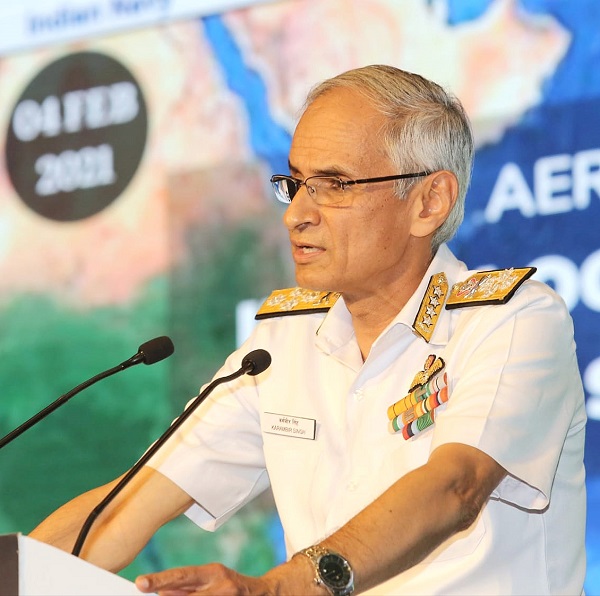New Delhi, (Samajweekly) The Navy’s aim is to create an enabling ecosystem that supports blue economy and to support the efforts of the government, Indian Navy chief Admiral Karambir Singh said on Friday.
“We have the resources, assets and domain expertise for mapping, characterising, monitoring as well as enforcing a good order at sea,” the Indian Navy chief said in a webinar on the ‘Role of Maritime Forces in Promoting a Blue Economy’.
He said that as Gunter Pauli, who had initiated the idea of Blue Economy in his 2010 thought-provoking book, put it, the challenge remains not only in harnessing the vast resources of the oceans, but to do it in a sustainable, equitable and efficient way.
“For the Indian Ocean Region, the challenges are significantly more diverse. Home to one-third of the world’s population, with 13 of the less developed economies, it is technology, resource mapping, exploitation, as also monitoring that remain the key limitations in harnessing the full potential of Blue Economy,” he said.
For India, Blue Economy offers an opportunity to make a transition from the “brown” economy development model on land, where sometimes unsustainable resource extraction constrains development.
“As India aims to emerge as a $5 trillion economy, the only way to achieve this, to my mind, is to move outwards. Here, the oceans provide us with a vast resource pool that can be tapped to spur India’s economic growth,” Admiral Singh said.
With the anticipated addition of the Extended Continent Shelf, the sea area will equal India’s land area.
“Combined with India’s location — a 7,516 km long coastline, 14,500 km length of navigable inland waterways, and 1,382 islands — I think the seas must become India’s ‘opportunity’ region in the coming future,” said Indian Navy chief, adding, “When we talk of Blue Economy opportunities for India, they span the entire spectrum, from energy to ecology, fishing to tourism.”
He said that there is much to do if India wishes to tap into the economic potential of the Indian Ocean Region (IOR).
Citing instances, he said that of the potential fish resource of 5.3 million metric tonnes in India’s Maritime Zone, only about 70 per cent is fished.
“Ninety per cent of this catch comes from fishing in up to 50m contour, highlighting the opportunities for deep-sea fishing. India’s offshore wind energy generation potential is more than 300 GW, one-tenth of which is currently planned to be tapped,” he said.
Large marine ecosystems in the Bay of Bengal comprise 8 per cent of the world’s coral reefs and 12 per cent of mangroves, opening up opportunities for coral reef tourism, apart from ecological conservation, he noted.
“While Blue Economy contributes to about 4 per cent of India’s GDP, I think there is tremendous potential to expand its contribution,” he said.
The Indian Navy chief also said that Prime Minister Narendra Modi has laid emphasis on India emerging as one of the leading Blue Economies of the world, with all maritime stakeholders joining hands to achieve this goal.
The Indian Navy is a key stakeholder in realising this vision and its strength lies in ensuring safety, security and good order at sea. This is critical to enable commerce and trade to thrive in a stable and sustainable manner, he said.
He also talked about how the Indian Navy is focussing on securing the Blue Economy. “In this endeavour, the Navy aims to be both an enabler and an element of national and regional Blue Economy efforts,” he said.
In terms of being an enabler, the Navy chief highlighted three ways in which the Navy contributes to the Blue Economy.
The first is by maintaining comprehensive maritime domain awareness. Second, by coordinating with various national and international maritime agencies. And finally, by supporting maritime capability development of littoral nations.
“Seychelles, for example, has made notable strides in developing a strong Blue Economy. However, with an EEZ two-third the size of India’s EEZ, maintaining effective surveillance remains a challenge,” he said.
The Navy chief said that Mauritius has an EEZ, which is 1000x its landmass. The recent oil spill from MV Wakashio close to a marine park highlights the impact of such incidents on fragile marine ecosystems.
“In this, we support the partner nations through construction of patrol vessels, installation of radar chains, training support, information sharing and joint EEZ surveillance,” he said.
“In terms of discharging our role as an element of Blue Economy, our hydrographic capability constitutes the building block for the Blue Economy. Secondly, supporting ship-building. Another area is data collation,” the Navy chief said.
The Indian Navy is also lending support to the national Deep Ocean Mission, which aims to send a manned mission to 6000m depth for survey of poly-metallic nodules, hydrothermal deposits, as also research on deep-sea bio-diversity.
“The Navy’s experience in operating manned and unmanned submersibles, and our understanding of the underwater domain would pool into this national effort,” he said.
The Navy is also supporting organisations such as IORA in their regional efforts. The 23-member grouping has emphasised development of Blue Economy through a “common vision for balanced economic development in the Indian Ocean Rim”.
“We support this initiative through participation in various working groups, preparation of HADR SOPs, as also information-sharing on critical issues through an MoU planned between the Navy and the IORA member states,” Admiral Singh added.
Download and Install ‘Samaj Weekly’ App
https://play.google.com/store/apps/details?id=in.yourhost.samajweekly










